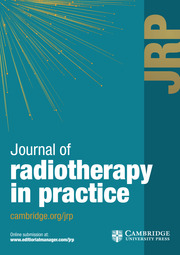Article contents
Radiotherapy for histiocytic sarcoma: a case report
Published online by Cambridge University Press: 09 January 2015
Abstract
Histiocystic sarcoma is a rare, but aggressive tumour that often involves extranodal sites. Histiocystic sarcoma is recognised by the World Health Organization as one of six subtypes of dendritic cell neoplasms. Diagnosis is difficult due to overlapping immunohistochemistry with other dendritic cell neoplasms. The optimal roles for chemotherapy, radiotherapy and surgery in the treatment of histiocytic sarcoma remain unknown.
We report a case of a patient with histiocytic sarcoma diagnosed after excisional biopsy and immunohistochemistry testing.
The patient underwent external beam radiation therapy (EBRT). After 18 Gray (Gy), the 8 cm lesion had regressed to ~5 cm in diameter. The treatments were continued to a total dose of 45 Gy with the lesion regressing to less than a centimeter by the end of treatment. Local control was maintained but the patient died of acute myelogenous leukemia 5 months after her treatment.
This case suggests that histicytic sarcomas can be controlled locally with EBRT.
- Type
- Case Study
- Information
- Copyright
- © Cambridge University Press 2015
References
- 1
- Cited by



